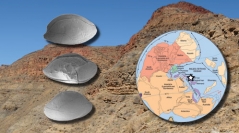

 Geodiversitas
46 (5) - Pages 119-133
Geodiversitas
46 (5) - Pages 119-133Ostracod (Crustacea) fossils can only be determined by observation of the carapace and for this they have to be extracted from the rocks. Generally, in Late Palaeozoic rocks, these microfossils are preserved in hard limestones. The most common method of their extraction is hot acetolysis. We test here two other methods for ostracod extraction from the Guadalupian - Lopingian (Late Permian) Ali-Bashi section in the Northwest of Iran. The samples were prepared with cold 10% formic acid (CH₂O₂) or 15% acetic acid (CH₃COOH). The CH₂O₂ protocol was productive with well-preserved ostracods, allowed us to determine ten taxa as Bairdia deducta deducta (Zalányi, 1974), Bairdia hungarica Zalányi, 1974, Bairdia sp., Fabalicypris parva Wang, 1978, Fabalicypris sp. 1, Fabalicypris sp. 2, Hollinella (Hollinella) herrickana (Girty, 1909), Hollinella sp., Sargentina transita (Kozur, 1985) and Silenites sp. Amongst these assemblages, Hollinella (Hollinella) herrickana (Girty, 1909), Fabalicypris sp. 2, Sargentina transita (Kozur, 1985) and Silenites sp. were obtained exclusively through the diluted CH₂O₂ protocol from the hard dolomitized limestones, while the other hot and cold procedures were unsuccessful.
Guadalupian-Lopingian, Northwest Iran, Ostracods, extraction process CH₂O₂, CH₃COOH.